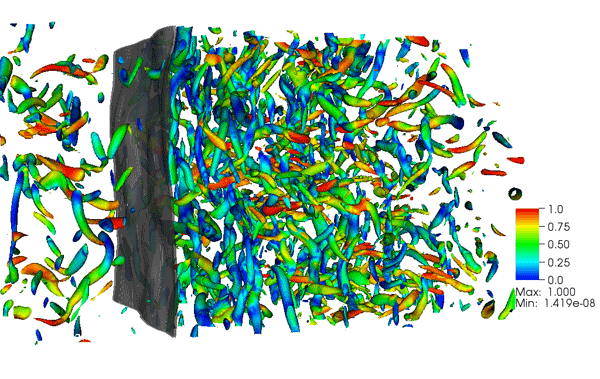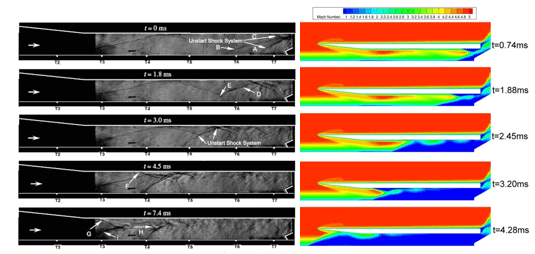| Shock waves inevitably appear in supersonic flows. In a scramjet engine, a sequence of oblique shocks is used to slow down and compress the air prior to fuel injection and combustion. The nature of the inlet/isolator system is such that all these shocks impinge upon, and are reflected by, the thin turbulent boundary layers on the walls. The strongly adverse pressure gradient imposed upon the boundary layer is often sufficient to cause separation. The separated shock/boundary layer interaction system is unstable and oscillates (growing and shrinking; moving back and forth) at low frequencies, which can affect the mixing and combustion processes occurring downstream. Finally, during an unstart event (say, caused by thermal choking), there is experimental evidence suggesting that the multiple shock/boundary layer interactions play a role in propagating the unstart event upstream. |
| |
| |
| Objectives |
The shock group is working on many aspects of shock/turbulence interactions. We're interested in developing and analyzing numerical methods for high-fidelity simulations of high-speed turbulent flows with shocks. We have studied very fundamental aspects of the shock/turbulence interaction problem with a view towards increased physical insight, but we are also working on translating these insights into improved engineering turbulence models (RANS). Much of our work is on large eddy simulation of these flows, where we necessarily must focus on the aspect of how to model (rather than resolve) the inner part of the boundary layer. Our broad objectives (not necessarily in order of priorities!) are:
- Develop numerical methods for high-speed turbulent flows that are robust, non-dissipative, and that can efficiently utilize the largest computers in the world.
- Deepen our insight into the shock/turbulence interaction process, including the low-frequency unsteadiness of shock/boundary layer interactions, with a view towards both better engineering modeling and future control strategies.
- Develop improved high-fidelity (LES) and low-fidelity (RANS) models that accurately capture the shock/turbulence interaction process in a robust manner that is free from problem-specific tuning.
- Understand and quantify the uncertainties in the shock/boundary layer interaction, specifically how it impacts the global unstart phenomenon (both to what degree it impacts, and what specific aspect of it that impacts).
|
| |
| |
| Approach and Results |
| |
| Numerical methods |
| We currently use 2 different types of numerical methods: hybrid methods that apply different numerics near and away from shock waves, respectively, in a solution-adaptive manner; and methods using artificial viscosities and diffusivities to capture shocks. In both cases have we published improvements to the existing state-of-the-art, and in both cases did we start with high-order methods on structured grids but then quickly started translating our ideas to general purpose unstructured codes (Charles). Our main contribution to the hybrid class of methods has been a mathematical analysis of the numerical stability at the interface coupling the different schemes. Within the artificial viscosity class of methods, our main contributions have been to reduce the effect on compressible turbulence and the sound it produces, and to make the approach applicable to boundary layer flows. |
| |
| Fundamental shock/turbulence interaction physics |
| Within the PSAAP project we are leveraging some results from our SciDAC-2 sponsored sister-project (shocks.stanford.edu). Specifically, we use the datasets from the direct numerical simulations (DNS) of canonical shock/turbulence interaction (produced in the SciDAC-2 project) for model verification and to guide our LES and RANS model development. These unique datasets were created in simulations on up to 65,536 cores on the BG/P machine at Argonne. The figure below shows the essential process in a small sub-domain, with turbulent eddies (worm-like objects, colored by the cosine angle between their orientation and the shock-normal axis) being modified and amplified as they pass the shock (grey sheet-like object). Note the anisotropic orientation of the post-shock eddies. |
 |
| |
| RANS of realistic inlet/isolator geometries |
| We are using the unstart experiment from the Clemens-group at UT Austin to validate our RANS computations, specifically how the unstart event progresses upstream through the many shock/boundary layer interaction sites. The unstart is initiated in the experiment by raising a mechanical flap that chokes the inlet/isolator flow; this is emulated in the RANS computations. The figure below shows the progression of the unstart event in the experiment (left) and computation (right). Note the (relatively) slow propagation of the unstart-"wave" towards the upstream. In this work we have also investigated how the domain size and lateral boundary conditions affect the results. |
 |
| |
| LES of shock/boundary layer interaction |
| We are considering the problem of an oblique shock impinging upon a turbulent boundary layer. One key problem is the onset of low-frequency shock-motion, which leads to very high pressure and temperature rms-values near the foot of the shock. This problem was also the focus of 2 projects during the 2010 CTR Summer Program, where we collaborated closely with visiting researchers from France and Italy. Our findings to date show that LES is clearly capable of predicting the key physics, and also (in very preliminary work) that LES with wall-modeling can capture the basic dynamics. Our continuing work in this area includes modal decompositions of the low-frequency motions and linear stability analysis. The figure below shows the essence of the problem, from an experiment (left) and a large eddy simulation (right). |
 |
| |
| Improved RANS models for shock/turbulence interaction |
| The essential problem in RANS modeling of shock/turbulence interaction is that the commonly used eddy viscosity hypothesis is fundamentally and qualitatively wrong in shock waves. The eddy viscosity hypothesis assumes that turbulent stresses are related to the rate-of-strain; during rapid compression (such as in a shock), however, it is easy to show that turbulent stresses are instead related to the total amount of strain. In other words, turbulence is elastic during rapid compression. The error introduced by the eddy viscosity hypothesis can prevent grid-convergence; e.g., with the standard k-epsilon model the jumps in k and epsilon across the shock grow indefinitely as the grid is refined. While this behavior can be cured (e.g., by using the realizability constraints), there is no reason to believe that the resulting model predicts the correct shock-amplifications of turbulence kinetic energy and dissipation-rate. |
| |
| In this work we are investigating better ways to modify existing RANS models to ensure that they accurately handle shocks. Our approach is two-fold: we are investigating different re-formulations of the modeled equations such that they give the correct shock-amplifications (while maintaining the behavior away from shocks), and we are using the DNS datasets to guide and inspire the modeling in the shock-region (note that most standard arguments and assumptions used in deriving the turbulence models are inapplicable or even wrong at the shock). This work is very challenging, but has the potential to really move RANS modeling of high-speed turbulent flows onto a higher level of realism. |
| |
| Interactions (within and beyond) PSAAP |
| On numerical methods we work closely with many others, including Frank Ham and Rene Pecnik who are the lead developers of the Charles and Joe codes, respectively. In fact, some algorithmic ideas (e.g., the hybrid approach of using different schemes for shocks and turbulence) evolved first in the SciDAC-2 project for high-order Cartesian grids, then were adapted for unstructured grids in the Charles and Joe codes within the PSAAP project. |
| |
| On uncertainty quantification, Gianluca Iaccarino is a natural catalyst and interface. Similarly, the experiment on shock/boundary layer interaction with uncertain boundary conditions by David Helmer and John Eaton is in a natural way related to the work within the Shock-Dynamics topical group. Finally, our work on assessment and improvement of turbulence models for RANS is closely related to the work of Karthik Duraisamy. |
| |
| A very useful catalyst for interactions has proven to be our Shocks Meetings. Work on shock/turbulence interaction grew rapidly at the Center for Turbulence Research with the start of our SciDAC-2 project in late 2006. When other projects involving shocks started later (including the PSAAP project, but also others), we started informal regular meetings among anybody interested in shocks and compressible turbulence. We meet roughly every 3 weeks on Wednesdays in the CTR conference room. Anybody who is interested should contact either Johan Larsson or Ivan Bermejo-Moreno for the exact meeting times and topics. |
| |
| Finally, the PSAAP project has benefited from our previously mentioned SciDAC-2 sponsored project, with has generated numerical developments, high-resolution DNS datasets, and general insight into shock/turbulence interaction that have all fed into the PSAAP project. |
| |
| |
| People |
| |
| Name |
Email address |
Focus |
| Prof. Sanjiva Lele |
lele@stanford.edu |
All aspects |
| Prof. Parviz Moin |
moin@stanford.edu |
All aspects |
| Dr. Johan Larsson |
jola@stanford.edu |
Canonical shock/turbulence interaction; numerical analysis |
| Dr. Soshi Kawai |
skawai@stanford.edu |
Jet in crossflow; wall-modeling in LES |
| Dr. Ivan Bermejo-Moreno |
ibermejo@stanford.edu |
Subgrid-modeling in LES |
| Dr. Frank Ham |
fham@stanford.edu |
Numerical methods |
| Dr. Rene Pecnik |
renep@stanford.edu |
RANS modeling |
| Brandon Morgan |
bmorgan1@stanford.edu |
LES of shock/boundary layer interaction |
| David Dawson |
ddawson@stanford.edu |
LES of shock/boundary layer interaction |
| Simon Plucinski |
splucins@stanford.edu |
RANS modeling for shocks |
| Ik Jang |
ikj@stanford.edu |
RANS of scramjet inlet/isolator |
|
| |
| |
[an error occurred while processing this directive]

